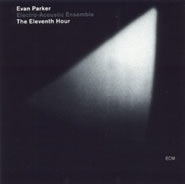
Evan
Parker Electro-Acoustic Ensemble
The
Eleventh Hour
(ECM)
If
at the time of Hall Of Mirrors (the excellent album from 1990 where
the sound of his saxophone had been modified by Walter Prati’s real-time
treatments) it was maybe still possible to consider Evan Parker’s new
attention for electronics as just a bit of a curio, almost a footnote
in the very long career of this extraordinary musician, today it’s quite
apparent that the music that came out of this has proved Parker’s intuition
to be right: though it has benefited greatly from the innovative possibilities
(technical, timbral, organizational) of the new electronic means, his
music has continued to sound as being easily recognizable as his own;
open and new, yet definitely aware of teleology; sometimes particle-like,
but at the same time never impossible to be appreciated in the (relative)
quiet of a modern apartment; bearing traces of the improviser’s gesture,
yet perfectly able to survive the "blind" condition of those
who listen to CDs. Forgetting about the other electronic duo album recorded
by Parker – Solar Wind (1997), with Lawrence Casserley – would not be
fair, but I’d call the four albums recorded under the name Electro-Acoustic
Ensemble as the best example of what he has released in this field.
Listening
to those four albums one after the other can be an instructive (and
definitely beautiful) experience. Toward The Margins (1997) saw Parker’s
sax alongside old friends Barry Guy on double bass, Paul Lytton on percussion
and Philipp Wachsmann on violin and viola; but the new element in the
picture was the "sound processing" of Walter Prati and Marco
Vecchi – and Wachsmann’s. The electronics of the above-mentioned Lawrence
Casserley were the added element of the following album, Drawn Inward
(1999). Things changed greatly with Memory/Vision (2003): recorded (with
great clarity) live in Oslo, the work featured a nonet where Agustí
Fernandez’s piano and prepared piano and Joel Ryan’s computer and sound
processing were added to the aforementioned instrumentation; such a
big line-up, plus the use of tapes from previous performances, produced
quite a full sound of great, almost orchestral-like impact. This time
the liner notes were quite brief, but here Parker wrote of a "framework",
of an "underlying structure".
The
new album features an even larger line-up, now an 11-strong ensemble.
On double bass, Adam Linson replaces Barry Guy (but his instrumental
voice has less weight), while new members Richard Barrett and Paul Obermayer
(known as a duo under the name FURT) play samplers; Parker and Casserley
are also on vocals. Reading of such a large line-up made me think of
an even bigger, thicker sound than the previous album, but in fact the
opposite is true.
Recorded
live in Glasgow in November 2004, the album features two separate pieces,
each recorded on different nights under quite different circumstances.
Shadow Play, the 17-minute long opening track, features a quartet: an
improvisation by Parker on soprano is framed by the electronics and
treatments of Lawrence Casserley, Joel Ryan and Walter Prati; results are
very Parker-like, with the distinctive arpeggios and the cells; mostly
quite hushed, with a dramatic increase of dynamics at about 10′. In
five parts, about 55′ long, The Eleventh Hour is quite various; repeated
listening sessions seem to reveal a structure.
(Wouldn’t you be happy if you could read "Over the course of
a week Parker rehearsed his expanded 11-piece ensemble, refining and
adjusting the new piece, and each evening the ensemble members played
in different semi-ad hoc combinations"? Well, I’d definitely be.
But to read this, you have to pay a visit to the Web, where some sort
of liner notes are to be found. Now, given the times, I’d say that those
who choose to pay money for a physical CD definitely deserve, if not
a free DVD-V of the concert, at least some liner notes!)
The
development of the piece sees some sort of "solo space" for
some among the instrumentalists: track 1 sees what to me sound as a
louder Barrett/Obermayer, while track 2 offers solo space to Wachsmann’s
violin and track 3 highlights Lytton’s percussion and Fernandez’s piano
(this piano part being the only thing on the CD that to me sounded kinda
long-ish); track 4 sees more of a typical Parker air, and more saxophone.
But these are just general observations, given the fact that the ever-changing
timbral palette, sometimes of a quite "mysterious" nature,
and the ever-changing instrumental "weight" of the music make
for a perennial surprise. With its excellent recorded sound, The Eleventh
Hour could maybe in time reveal itself to be the best album that the
ensemble has recorded to date.
Beppe
Colli
©
Beppe Colli 2005
CloudsandClocks.net
| Sept. 29, 2005


